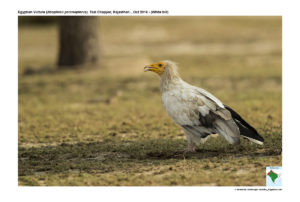Egyptian Vulture

Egyptian Vulture Neophron percnopterus
Etymology:
- Neophron : Based on Greek mythology Neophron, a trickster metamorphosed into a vulture
- Percnopterus : Greek word perknos –dark; pteros-winged
Vernacular Names: Sind: Hil, Hindi: Safedgidh, Kolmurghab, Kalmurgh, Kash: Patyaal, Pun: Chittigidh, Bi: Get gidh, Ben: Shwetshakun, Guj: Kherogidh, Safedgidh, Te: Tellaborawa, Peethirigadda, Ta: Manjalthirudi, Mal: ThottiKazkhukan, Mar: Egyptian Gidhad, PandhareGidhad
It is also known as Pharaohs Chicken
Distribution in India:Resident in North and Central India.
Description: Size of 54–70 cm;wt. of 1600–2400 g; wingspan of 146–175 cm. The adult’s plumage is white, with black flight feathers in the wings. The bill is slender and long, and the tip of the upper mandible is hooked. The nostril is an elongated horizontal slit. The neck feathers are long and form a hackle. The wings are pointed, with the third primary being the longest; the tail is wedge shaped. The legs are pink in adults and grey in juveniles. The claws are long and straight, and the third and fourth toes are slightly webbed at the base. The bill is black in the nominate subspecies but pale or yellowish in adults of the smaller Indian ginginianus. The facial skin is yellow and unfeathered down to the throat. The sexes are indistinguishable in plumage but breeding males have a deeper orange facial skin colour than females. Females average slightly larger and are about 10–15% heavier than males. Young birds are blackish or chocolate brown with black and white patches. The adult plumage is attained only after about five years.
Habitat: It is found in extensive open areas mainly in dry or arid regions, sometimes around fringe areas of wet or cold climates. It is found also around steppe, desert, scrub, pastures and fields of cereals; requires rocky sites for nesting. It is found from sea-level to 4000m.
Food habits: It feeds on varied types of food. It eats mainly carrion, including all sorts of dead vertebrates, from passerine birds and small mammals to livestock, dead dogs and large wild animals. It normally eats only scraps of large carcasses, rejected by other vultures. Sometimes preys on small animals, often weak or injured ones, like rabbits, chicks, spawning or dying fish, and terrapins, also insects, bird eggs. It breaks the eggs by throwing stones at them, usually selecting a very specific size.
Breeding habits: They breed in Nov–Apr in Nigeria, May–Dec in Kenya, Feb–Aug in Sudan and Eritrea; Oct–Dec in South Africa; Mar–Apr in Punjab, Canary Is and N Africa; Feb–June in Uttar Pradesh; Apr–May throughout Mediterranean range and Oct–May on Socotra. They nest on cliffs, occupying caves or ledges protected by overhang; very occasionally in trees, sometimes occupying old nest of another raptor, and rarely nesting on ground or atop a termite mound. The nest is a stick nest constructed by both sexes, usually lined abundantly with wool, hair, rags and remains of food, even excrement .The breeding pairs often have several nests, alternating between them annually, but sometimes re-use same nest in consecutive breeding seasons. The male may occasionally prepare female for copulation by offering food, and mutual preening can also be a precursor to this. They lay a clutch of two eggs, laid at 3–5-day intervals. The incubation period is 39–45 days. Both the adults incubate eggs and feed chicks. The fledging period is 70–90 days followed by one month of dependency on adults.